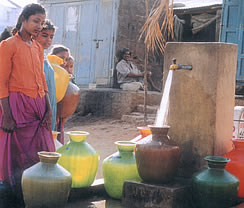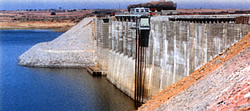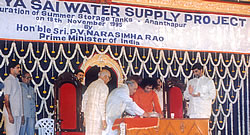

Institutions and Projects - Sri Sathya Sai Water Supply Project

![]() For
millions in Rayalaseema, Andhra Pradesh, getting pure drinking water was
a daily drudgery. It meant trudging long distances and often in vain.
And then, the Sri Sathya Sai Central Trust decided that the villagers
need never again trek for something which ought to be on their tap.
For
millions in Rayalaseema, Andhra Pradesh, getting pure drinking water was
a daily drudgery. It meant trudging long distances and often in vain.
And then, the Sri Sathya Sai Central Trust decided that the villagers
need never again trek for something which ought to be on their tap.
The Impossible began to take Shape
 The
result - Sri Sathya Sai Water Supply Project covering more than 700 villages
in Ananthapur district and providing water to a million people who lived
all their lives on the edge of drought and despair. This was made possible
- in less than a year by Bhagawan Sri Sathya Sai Baba, who reached out
to the forgotten villages with a deep sense of urgency, and the project
was completed with speed and efficiency. In November 1994, Sri Sathya
Sai Central Trust, the Panchayat Raj department of Government of Andhra
Pradesh and the construction unit of Larsen and Toubro moved quickly,
submitting plans for providing drinking water to more than 700 villages
and urban centres such as Ananthapur, Kadiri and Dharmavaram.
The
result - Sri Sathya Sai Water Supply Project covering more than 700 villages
in Ananthapur district and providing water to a million people who lived
all their lives on the edge of drought and despair. This was made possible
- in less than a year by Bhagawan Sri Sathya Sai Baba, who reached out
to the forgotten villages with a deep sense of urgency, and the project
was completed with speed and efficiency. In November 1994, Sri Sathya
Sai Central Trust, the Panchayat Raj department of Government of Andhra
Pradesh and the construction unit of Larsen and Toubro moved quickly,
submitting plans for providing drinking water to more than 700 villages
and urban centres such as Ananthapur, Kadiri and Dharmavaram.
Four Schemes

Sri Sathya Sai Water Supply Project consists of four schemes:
- Comprehensive Protected Water Supply Schemes involving infiltration wells, collection wells and associated pumping stations behind the Chitravati Balancing Reservoir at Paddakotla and Chinnakotla, covering 169 villages. Sources for other infiltration wells include Pennar and Hagari river which cover 93 villages.
- Direct pumping from Penna Ahobilam Balancing Reservoir and treatment through rapid sand filtration system. This consists of two major lines passing through Kalyandurg and Atmakur, covering 93 villages.
- Comprehensive Water Supply Schemes through seven summer storage tanks ranging up to 100 acres by tapping water from Tungabhadra High Level Canal, when water flows in the canal, covering 97 villages.
- The Protected Water Supply Scheme covers 279 villages. It involves drilling deep bore wells, construction of storage tanks and installation of pipeline networks.
 The
spirit of involvement extended to thousands of villagers who pooled in
their efforts to make the impossible come true. Significant features that
characterise the uniqueness of this project include:
The
spirit of involvement extended to thousands of villagers who pooled in
their efforts to make the impossible come true. Significant features that
characterise the uniqueness of this project include:
- Stringent time frame,
- Vast magnitude,
- Project cost funded by a charitable organisation.
Salient Features
- Laying of more than 2,000 km pipelines, ranging from 80 mm to 600 mm diameter.
- Construction of 43 pumps from 100,000 to 2,500,000 litre capacity.
- Construction of 18 balancing reservoirs at the top of hillocks with capacities ranging from 300,000 to 1,000,000 litres.
- Construction of 270 overhead reservoirs with capacities ranging from 40,000 to 300,000 litres.
- 125 ground level reservoirs with capacities ranging from 20,000 to 80,000 litres.
- Installation of more than 1,500 precast concrete cisterns of 2,500 liters capacity, with provision for four taps to be used by the villagers.
 Behind
it all is the power of commitment and service - a power that attracts
many talents and creates a synergy of efforts directed towards changing
the quality of life in the wilderness of Rayalaseema. And it all happened
because of the underlying spirit of Bhagawan Sri Sathya Sai Baba just
to create a new world for people long forgotten in the wilderness.
Behind
it all is the power of commitment and service - a power that attracts
many talents and creates a synergy of efforts directed towards changing
the quality of life in the wilderness of Rayalaseema. And it all happened
because of the underlying spirit of Bhagawan Sri Sathya Sai Baba just
to create a new world for people long forgotten in the wilderness.
Meeting the Need of Medak and Mehaboobnagar Districts
Medak and Mehaboobnagar districts of Telengana region in Andhra Pradesh are drought prone and fluoride affected. Bhagawan Sri Sathya Sai Baba willed that pure, safe drinking water must be literally poured into the parched life of people of the two districts. Hence the project took off during March 1999 and Sri Sathya Sai Central Trust, Puttaparthi provides drinking water to 320 habitations in these districts.
145 villages in Mehaboobnagar and 175 villages in Medak districts profit from this project. 12 comprehensive protected water supply schemes were installed, covering 250 villages. Another 70 individual protected water supply schemes serve 70 villages with bore wells as sources.
The engineering work included the construction of civil structures such as water treatment plants, overhead reservoirs, ground level reservoirs, pump houses etc. as well as project management services for the execution of mechanical and electrical works. The total length of the pipelines is approximately 800 km including various types of pipes such as AC, PVC, HDPE, PSC, GI and MS of diameters ranging from 63 to 600 mm.
Work commenced in May 1999 and a total of 290 villages were completed by 23rd November 2000, i.e. on the 75th birthday of Bhagawan Sri Sathya Sai Baba.